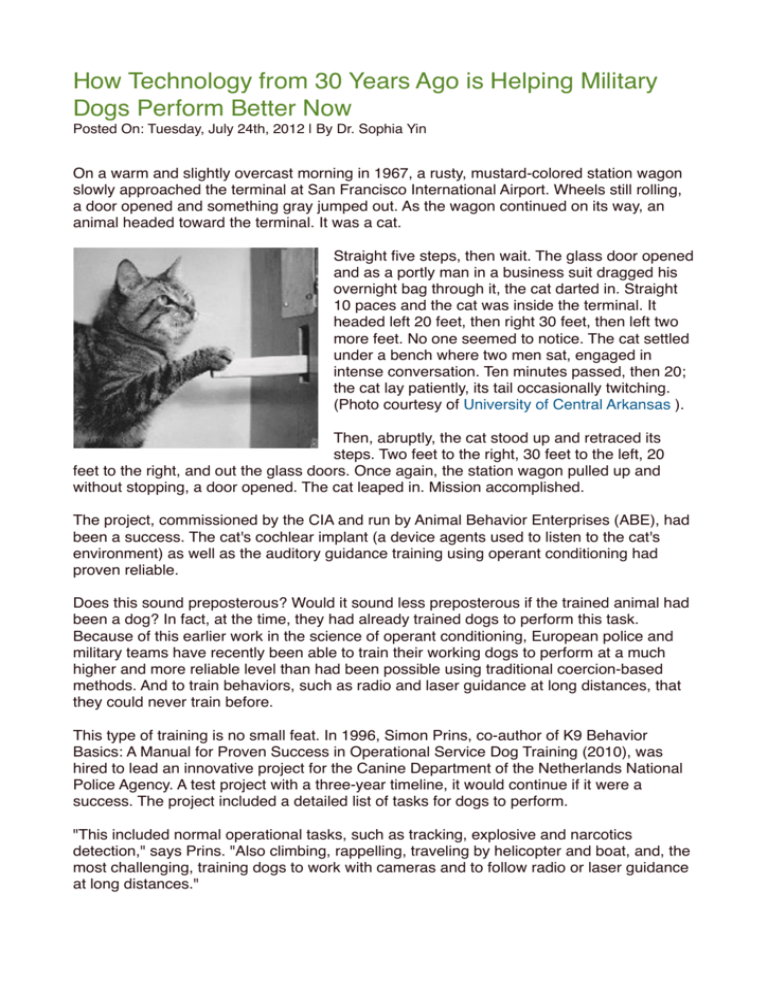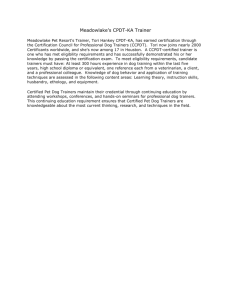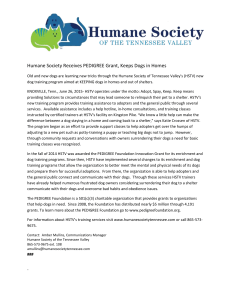How Technology from 30 Years Ago is Helping Military Dogs
advertisement

How Technology from 30 Years Ago is Helping Military Dogs Perform Better Now! Posted On: Tuesday, July 24th, 2012 | By Dr. Sophia Yin! On a warm and slightly overcast morning in 1967, a rusty, mustard-colored station wagon slowly approached the terminal at San Francisco International Airport. Wheels still rolling, a door opened and something gray jumped out. As the wagon continued on its way, an animal headed toward the terminal. It was a cat. Straight five steps, then wait. The glass door opened and as a portly man in a business suit dragged his overnight bag through it, the cat darted in. Straight 10 paces and the cat was inside the terminal. It headed left 20 feet, then right 30 feet, then left two more feet. No one seemed to notice. The cat settled under a bench where two men sat, engaged in intense conversation. Ten minutes passed, then 20; the cat lay patiently, its tail occasionally twitching. (Photo courtesy of University of Central Arkansas ). Then, abruptly, the cat stood up and retraced its steps. Two feet to the right, 30 feet to the left, 20 feet to the right, and out the glass doors. Once again, the station wagon pulled up and without stopping, a door opened. The cat leaped in. Mission accomplished. The project, commissioned by the CIA and run by Animal Behavior Enterprises (ABE), had been a success. The cat's cochlear implant (a device agents used to listen to the cat's environment) as well as the auditory guidance training using operant conditioning had proven reliable. Does this sound preposterous? Would it sound less preposterous if the trained animal had been a dog? In fact, at the time, they had already trained dogs to perform this task. Because of this earlier work in the science of operant conditioning, European police and military teams have recently been able to train their working dogs to perform at a much higher and more reliable level than had been possible using traditional coercion-based methods. And to train behaviors, such as radio and laser guidance at long distances, that they could never train before. This type of training is no small feat. In 1996, Simon Prins, co-author of K9 Behavior Basics: A Manual for Proven Success in Operational Service Dog Training (2010), was hired to lead an innovative project for the Canine Department of the Netherlands National Police Agency. A test project with a three-year timeline, it would continue if it were a success. The project included a detailed list of tasks for dogs to perform. "This included normal operational tasks, such as tracking, explosive and narcotics detection," says Prins. "Also climbing, rappelling, traveling by helicopter and boat, and, the most challenging, training dogs to work with cameras and to follow radio or laser guidance at long distances." ! Although Prins had been a patrol-dog handler in the regional police force for only a few years, he was selected for this project because he was seen as an innovator. "I had been questioning our traditional force techniques because I noticed that dogs would shut down and stop working, or my police dog would become aggressive to me and to the trainer. So I was already looking for new methods."! Why Choose Science Over a 4,000-Year-Old Craft?! New methods were what the job was all about. "The traditional [force-based] trainers all said that radio or laser guidance was not possible," says Prins. But he was sure there must be a way; so, even though he would not be able to return to his old job if he failed, he accepted the challenge. Within three years, he had succeeded in completing all of the tasks set for him, as well as a few more.! ! At this point, you may be asking yourself -- given the fact that people have been training dogs for more than 4,000 years -- why did traditional trainers feel these new tasks were impossible. Also, if a guidance system had already been developed for cats in 1967 in the U.S., why did it take Prins three years to reinvent the wheel 30 years later?! ! Bob Bailey, who worked on the 1967 project and later become co-owner of Animal Behavior Enterprises after marrying its co-founder, Marian Breland, explains. According to Bailey, it was the advent of animal training and behavior as a science that allowed them to develop the system for dogs, cats and, later, dolphins. "Dog training has been practiced as an ancient craft," says Bailey. "The science of training wasn't developed until the 1940s with B.F. Skinner."! ! What's the difference between craft and science? According to Bailey, "Crafts generally develop over thousands of years and tend to preserve what's old and what has been done before. Information is passed down in secret from master to apprentice, and the apprentice must never question the master." As a result, when errors are introduced, they tend to be preserved. Another characteristic of a craft is that a change is usually designed only to solve an immediate problem. Says Bailey, "Rarely do they look for general principles."! ! Science, on the other hand, is a systematic way of asking questions, a process that eventually weeds out mistakes. It's guided by principles and data, approaches change and are revised as new information comes to light. As a result, science advances quickly compared to craft.! ! Bailey backs up his description with an example: "For 1,000 years, the Chinese used gun powder to build small rockets. Then the Turks decided to build bigger ones, which they used on the British. It took them 800 years to develop the technology." Then, in the 1900s, science and technology stepped in. In 1926, American rocket pioneer Robert Goddard launched the first liquid-propellant rocket. In 1969, less than 50 years later, the U.S. sent a rocket to the moon.! ! "So it took 800 years of craft to send a six-foot rocket half a mile and less than 50 years of science to send a rocket to the moon," Bailey summarizes.! ! How Science Left the Lab and Leaped into the Field! ! Once the psychology of learning became a science, animal training made the same great strides. In 1898, scientist Edward Thorndike first described the principle of operant conditioning. Using cats and a small cage called a puzzle box (pictured to the left), with food outside the box, he found that cats placed in the cage could learn how to get out, and that with each trial, they got faster at it. He theorized that the cats were learning by trial and error.! Others were making discoveries at the same time, but the one who really put things together was B.F. Skinner. Through many experiments, Skinner developed the principles of operant conditioning, which described how animals learn to cope with their environment.! ! Skinner found that animals learn to repeat behaviors with reinforcement through positive consequences and to stop performing the behaviors when the reward is abruptly discontinued. He found that animals learn best when the consequence is timed exactly to the behavior, and that the rate at which animals learn is directly proportional to the rate at which the behavior is reinforced.! ! Research and technology advanced quickly, and within only eight years, operant conditioning had made its way out of the lab into an applied setting. During World War II, Skinner, who wanted to help with the war effort, set out to train pigeons to guide missiles by pecking at an image of the target site on a screen in a project called Project Pigeon. ! To demonstrate to the navy how it worked, Skinner took six pigeons and the apparatus in which they were trained to Washington, D.C. The demonstration was successful, but the navy turned him down; the admirals may have been taken aback when Skinner opened the chamber, which resembled a Pelican missile warhead, and they saw three pigeons pecking away. (Photo courtesy of University of Central Arkansas ).! ! Two of Skinner's graduate students, Marian Breland and her husband, Keller Breland, had dropped out of their degree programs to help with "Project Pigeon." They learned a lot while working with Skinner, more than they had learned in class, and became skilled at shaping -- a process by which a goal behavior is taught in increments, systematically rewarding intermediate behaviors. They also learned about secondary reinforcers -unique tones such as a clicker or whistle that, when paired with food, could be used to tell the animal exactly when it had done something right.! ! The couple, who saw how powerful these non-force techniques could be, decided that when the war was over, they would get into some kind of business where they would use operant technology to help solve problems for animals and, later, humans. In 1947, they founded Animal Behavior Enterprises (ABE), whose mission was to demonstrate that operant conditioning could get better and faster results and with little or no use of aversives.! ! ! They started with dogs, but trainers shunned the new method, claiming that people had been successfully training for centuries and no new approaches were needed. Rebuffed on the canine front, the Brelands turned to other species. For 47 years, ABE trained animals for its own theme park, the IQ Zoo, in Hot Springs, Arkansas, as well as for shows across the country. At ABE's height, the Brelands could have up to 1,000 animals in training at any given time, many for companies such as General Mills, who used them in commercials and at sales conferences. They also worked on animal behavior and training projects for organizations such as the U.S. Navy and Purina, as well as for Marineland of Florida and Parrot Jungle, where they developed the first of the now-traditional dolphin and parrot shows. When they started, there was only one trained dolphin, whom it had taken trainers two years to get ready to perform. In six weeks, Keller trained two new dolphins to perform the same behaviors. (Photo courtesy of University of Central Arkansas ).! ! Bob Bailey met the Brelands when he was hired as director of dolphin training for the navy and Keller and Marian were contracted to help. "I spent six months at ABE learning to train many animals, including chickens," he said. ! ! Three years later, the same year Keller passed away, Bailey joined ABE as assistant technical director and head of government programs. Later, he became research director too and then executive vice president and general manager. Eventually, he and Marian married.! ! Over the course of their career, the Baileys trained more than 140 species (or about 16,000 individual animals). In 1990, they retired and closed ABE. Then, in 1996, they received a series of calls from Simon Prins.! ! How the Military Convinced Marian and Bob Bailey to Help! "I'd spent a year traveling internationally and searching for training methods," says Simon. "I saw a dolphin show, and the girls were training the dolphins to perform incredible behaviors without shock collars or punishment devices. I did more research, and it all led back to Marian and Bob Bailey, so I contacted them," Prins recalls. It took 20 emails and 10 phone calls before the couple agreed to help. "Bob was quite rude ... he hung up on me many times."! ! "We didn't want to deal with police or military because in our experience, they are punishment-based," says Bob. In the U.S., the Baileys had come to feel that force-based trainers could not make the change to operant technology because eventually, they fell back on the method with which they were most comfortable. "These trainers take what we say and modify it. They take good operant conditioning principles and modify them, and then say they won't work."! ! Eventually, as Prins continued to meet Bob's increasing demands, Bob agreed to help. Prins came with a few other trainers, as well as his superiors, to the Baileys' Hot Springs headquarters to learn by training chickens.! ! Animal Behavior Enterprises had tested many animals for learning purposes and found that chickens provide by far the best training model . Prins and his bosses quickly learned that training is a technical skill rather than a mystical, inborn ability. A science, not a craft. They trained chickens to selectively peck just one type of object among a group of objects, and to perform tasks only on cue. They learned to train behaviors as a series of many little shaping steps, and to keep track of the outcome of each trial in order to determine whether they were having success or needed to fix their technique or plan. They did this all with positive reinforcement -- without physically manipulating the chickens.! ! ! Switching to This "New" Technology was a Challenge! "Bob and Marian changed my whole perspective on animal training," says Prins. As a result, he met all of the 1996 goals, and more. At first it was difficult. ABE had developed remote-guidance systems for cats, dogs and dolphins by 1967. In months, they could train dolphins to perform many behaviors, including traveling 12 hours on a circuitous eight-mile route with no reinforcement. It took Prins three years to work out the methods. (Photo: Simon Prins' dog, Andor, in gear)! ! "I talked to Bob by mail and phone, but it was difficult, because I was the only one here using these techniques," he recalls. The process required thinking about what he wanted, planning how he would get it, and then implementing the plan and collecting data. This was followed by an evaluation of the data and revisions to the plan based on the results. This process defines the field of applied animal psychology that the Brelands had created based on Skinner's work. It's something that most dog trainers are ill-equipped to do.! ! Whenever Prins got stuck, he fell back on his old habit of blaming the dog instead of recognizing that he had signaled the wrong behavior with his body language or poor timing or inadequate shaping plan. According to Bob, the traditional method of training would advise, "Get a bigger stick and beat the dog harder." He reminded Prins that he needed to stop blaming the dog and look more carefully at video evidence to see what was going wrong.! ! "He had been training under the eye of other trainers, who for many years [had taught] him it was the dog's fault, and you must correct the dog," says Bob. "If you're the one making the errors, you should be beating yourself, not the dog."! ! The three-year process was difficult, but he kept at it because he felt that it was the only way they could get the consistency and reliability they needed. As Prins explains, "If you have a punishment-trained dog, in the new situation when they are not sure what to do, they are afraid they will receive punishment, even if it is mild. Dogs just stop performing, [and] learning slows down or stops." He had already found that it was much more effective to condition an animal to see the world as a environment in which something positive could occur at any moment. ! Success! Faster Training and More Reliable Performance! So he stuck with it until he had the techniques down. As a result, the program was even more successful than anticipated. "Our dogs often work far from our position, often in the dark and always in an area they have never seen before," he says. While trainers prepare the dogs for many situations, they can never truly simulate real-time operations, which usually happen in unpredictable surroundings and are stressful for the human handlers. But by teaching dogs that performing in many different situations is fun, they are able to perform reliably.Training speed has also improved. "[With] the first dog, [it] took me eight months to train him to follow a laser. With operant-conditioning, it now takes me four weeks."! ! The training is heavily weighted toward positive reinforcement, but both Bailey and Prins point out that rarely, aversives are also used, but not until trainers understand operant conditioning well. They must first have completed all four operant conditioning (a.k.a. chicken training) workshops and been training extensively in it for six months. Then they may use an aversive only when a dog exhibits behavior that puts himself, humans or the operation at risk. The aversive may range from verbal reprimands to low-level shock. ! Before trainers use an electronic collar, they must wear the collar around their own necks and see what it's like to be trained this way. They find out what it feels like when a correction is given, and even worse, given at the wrong moment as commonly happens even with the most skilled trainers. "Then they understand how difficult it is, and they do not like to use it," says Prins. Overall, aversive methods comprise less than 1/1000 of the training.! ! Their success has led to other countries, including Belgium and Norway, adopting this approach. Despite the advantage of being able to learn from Prins's mistakes, all the trainers in his group experience some of what he did during his first three years. To select new trainers, Prins sends potential candidates through four five-day chicken training camps in Sweden. "The punishment trainers fall hard. We give them four days to see if they can make the change. The process is grueling," he observes. ! The change is worth it though. Trainers see the difference, and the proof is not just in their impressions. It's in the hard data: shorter training times; more dogs trained for less money; behaviors they could never train before, and more consistent, reliable dogs, which leads to more successful missions.! ! Bailey explains, that while some trainers are partially motivated by the fact that they don't like how they are treating their dog, "The trainers who actually make the changes are those, who want more success and recognize that simply beating their dog more will not get that additional success." Skill at operant technology is what will get them what they want. Once they embrace this idea they can make the changes that will allow their dog succeed. And as added benefit, the handlers can finally enjoy their work and so can their dog.!






